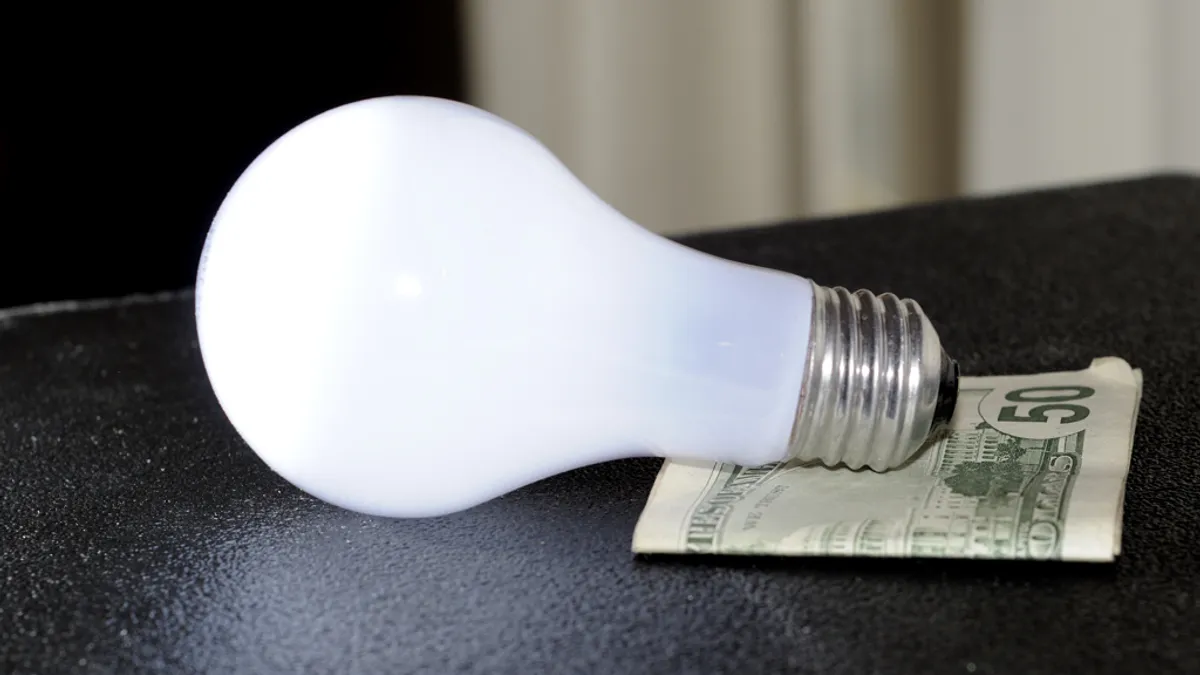UPDATE: Jan. 17, 2020: The two lighting associations that challenged California's lightbulb standards dismissed the lawsuit on Wednesday.
"Fifteen states and non-governmental organizations have challenged the DOE regulatory definition in the U.S. Court of Appeals in New York City, and that court expects a decision at the end of this year or early next year," the National Electrical Manufacturers Association said in a statement announcing the dismissal. "NEMA believes that awaiting this decision is the best approach to resolving the dispute and to providing a clear direction to finalize energy efficiency policy for the nation."
Dive Brief:
- California can begin prohibiting the sale of several types of less-efficient lightbulbs even as a challenge to its expanded standards continues to play out, the U.S. District Court for the Eastern District of California ruled Dec. 31.
- The California Energy Commission (CEC) in November adopted a 45 lumens/watt (LPW) energy conservation standard for five types of general service lamps (GSL), meaning incandescent and halogen versions are now being removed from retailer shelves. A similar standard covering common pear-shaped A-lamps has already been in effect in California for two years.
- California's new, expanded bulb definitions were the same as those updated by the Obama Department of Energy in 2017, but rejected by the Trump administration last September. Two lighting industry groups argued California's adoption of the expanded definitions last month violated the Energy Policy Conservation Act despite the state having an exemption to set its own rules for certain products.
Dive Insight:
Efficiency experts say disputes over more stringent federal standards for lightbulbs are likely to be resolved in court, but California will be allowed to implement them even as the DOE works to reverse course on an expansion of definitions begun under the Obama administration.
The judge's decision “keeps California at the forefront of the movement" to adopt more efficient technologies, Noah Horowitz, director of the Center for Energy Efficiency Standards at the Natural Resources Defense Council (NRDC), said in a statement.
California has had a 45 LPW standard in effect since 2018, which applied to A lamps and small diameter reflector lamps. The recent decision by the CEC expanded the scope to cover almost all shapes and base types, with some exceptions, including oven lamps.
According to NRDC, the updated standards could save California consumers $2.4 billion annually on utility bills, while avoiding up to 13,600 GWh of annual electricity use.
Other states have taken steps to ensure their consumers are accessing more efficient bulbs, but none have gone as far as California. Vermont, Colorado and Washington have passed their own 45 LPW standards, but don't have the same preemption rights as California and so their regulations impact a smaller list of bulbs, according to Horowitz.
Nevada is allowed an exemption and the state is in the process of finalizing its own standards, Horowitz added.
The National Electrical Manufacturers Association (NEMA) and American Lighting Association had asked the district court to issue a temporary restraining order blocking California from implementing the expanded standards.
The groups noted in their filing that California represents approximately 11% to 12% of the country’s light bulb market. NEMA and ALA argued that their members "operate in a standardized, global lighting supply chain that will be adversely affected by a patchwork of state efficiency regulations."
But the court said it concluded California's expanded regulations do not violate federal law because of "express exceptions to preemption" under the Energy Policy Conservation Act . "In enacting the exceptions to preemption, Congress recognized, among other things, California’s history of leadership in energy efficiency regulations," the court noted.
NEMA told Utility Dive it is "still reviewing the court’s decision" but noted that the judge denied the application for a temporary restraining order without prejudice, meaning the group can also pursue a preliminary injunction.
California and other states have sued the DOE for reversing the Obama administration's decision increasing the amount of commonly-used bulbs that must be about 65% more efficient than incandescent bulbs.
Along with lightbulbs, the Trump administration has proposed changes to the DOE's appliance efficiency standards program. In July, the agency proposed changes for residential furnaces and commercial water heaters that use natural gas or propane. DOE also wants to create a new class of dishwasher standards for units that could allow retailers to continue selling less-efficient models.
Along with the proposed changes for some product standards and definitions, under Trump, the DOE has missed 18 deadlines to review standards, according to NRDC. By law, the agency must review national appliance standards every six years.















